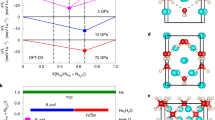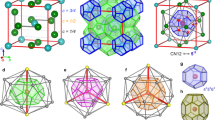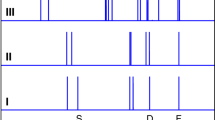Abstract
Since gas hydrates were shown in the mid-1950s1 to be water clathrates of two distinct crystallographic structures (Table 1), it has been generally accepted that structure I hydrates are formed by molecules with maximum van der Waals diameters of up to about 5.8 Å while structure II hydrates are formed by larger molecules, up to about 7.0 Å in size. No exception to this general rule has been observed among more than 100 individual species of molecules known to form clathrate hydrates2,3. From X-ray and neutron diffraction studies we now find, however, that the two smallest molecules which form clathrate hydrates—argon and krypton—do so in the structure II modification. This finding supports a suggestion of Holder and Manganiello4.
This is a preview of subscription content, access via your institution
Access options
Subscribe to this journal
Receive 51 print issues and online access
$199.00 per year
only $3.90 per issue
Buy this article
- Purchase on Springer Link
- Instant access to full article PDF
Prices may be subject to local taxes which are calculated during checkout
Similar content being viewed by others
References
von Stackelberg, M. & Müller, H. R. Z. Elektrochem. 58, 25–39 (1954).
Davidson, D. W. in Water: A Comprehensive Treatise Vol. 2 (ed. Franks, F.) 115–234 (Plenum, New York, 1973).
Ripmeester, J. A. & Davidson, D. W. Molec. Cryst. Liquid Cryst. 43, 189–195 (1977).
Holder, G. D. & Manganiello, D. J. Chem. Engng Sci. 37, 9–16 (1982).
Sargent, D. F. & Calvert, L. D. J. Phys. Chem. 70, 2689–2691 (1966).
Bertie, J. E. & Jacobs, S. M. J. chem. Phys. 69, 4105–4113 (1978).
van Cleeff, A. & Diepen, G. A. M. Rec. Trav. Chim. Pays-bas 84, 1085–1093 (1965).
van der Waals, J. H. & Platteeuw, J. C. Adv. Chem. Phys. 2, 1–57 (1959).
Ripmeester, J. A. & Davidson, D. W. J. molec. Struct. 75, 67–72 (1981).
Tse, J. S. & Davidson, D. W. Proc. 4th Can. Permafrost Conf., Calgary, Alberta (ed. French, H. M.) 329–334 (National Research Council, Ottawa, 1982).
Barrer, R. M. & Edge, A. V. J. Proc. R. Soc. A300, 1–24 (1967).
Bertie, J. E. & Jacobs, S. M. J. chem. Phys. 77, 3230–3232 (1982).
Author information
Authors and Affiliations
Rights and permissions
About this article
Cite this article
Davidson, D., Handa, Y., Ratcliffe, C. et al. The ability of small molecules to form clathrate hydrates of structure II. Nature 311, 142–143 (1984). https://doi.org/10.1038/311142a0
Received:
Accepted:
Issue Date:
DOI: https://doi.org/10.1038/311142a0
This article is cited by
-
Significance of the high-pressure properties and structural evolution of gas hydrates for inferring the interior of icy bodies
Progress in Earth and Planetary Science (2023)
-
Tensile properties of structural I clathrate hydrates: Role of guest—host hydrogen bonding ability
Frontiers of Physics (2021)
-
Formulating formation mechanism of natural gas hydrates
Scientific Reports (2017)
-
Self-preservation and structural transition of gas hydrates during dissociation below the ice point: an in situ study using Raman spectroscopy
Scientific Reports (2016)
-
Spectroscopic methods in gas hydrate research
Analytical and Bioanalytical Chemistry (2012)
Comments
By submitting a comment you agree to abide by our Terms and Community Guidelines. If you find something abusive or that does not comply with our terms or guidelines please flag it as inappropriate.



